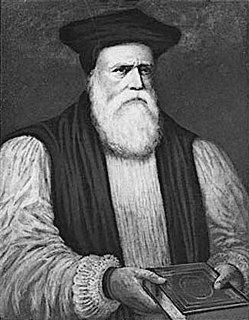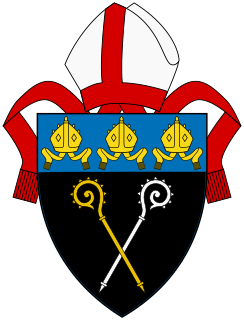Related Research Articles

David Lloyd George, 1st Earl Lloyd-George of Dwyfor, was Prime Minister of the United Kingdom from 1916 to 1922. He was a Liberal Party politician from Wales, known for leading the United Kingdom during the First World War, social reform policies including the National Insurance Act 1911, his role in the Paris Peace Conference, negotiating the establishment of the Irish Free State, disestablishment of the Church of England in Wales and support of Welsh devolution in his early career. He was the last Liberal Party Prime Minister; the party fell into third party status shortly after the end of his premiership.

William Morgan was a Welsh Bishop of Llandaff and of St Asaph, and the translator of the first version of the whole Bible into Welsh from Greek and Hebrew.

The Bishop of Llandaff is the ordinary of the Church in Wales Diocese of Llandaff.

Bangor Cathedral is a cathedral in Bangor, Gwynedd, Wales. It is dedicated to its founder, Saint Deiniol.
Elfodd, Elvodug or Elfoddw was a Welsh bishop. He induced the Welsh church to accept the Roman computus for determining the date of Easter endorsed elsewhere in Britain at the Synod of Whitby in 664. This was after centuries of continuing the practice.
Hugh Lloyd was a Welsh cleric who was the Anglican bishop of Llandaff from 1660 until his death in 1667.

The Cathedral Church of Saints Asaph and Cyndeyrn, commonly called St Asaph Cathedral, is a cathedral in St Asaph, Denbighshire, north Wales. It is the episcopal seat of the Bishop of St Asaph. The cathedral dates back 1,400 years, while the current building dates from the 13th century. The cathedral is part of the Church in Wales and part of the Anglican Communion of Wales.
This article is about the particular significance of the year 1890 to Wales and its people.
This article is about the particular significance of the year 1864 to Wales and its people.
This article is about the particular significance of the year 1857 to Wales and its people.
This article is about the particular significance of the year 1854 to Wales and its people.
This article is about the particular significance of the year 1843 to Wales and its people.
This article is about the particular significance of the year 1849 to Wales and its people.

John Lloyd, born at Pendine, Carmarthenshire, Wales, the son of Morgan Lloyd, was principal of Jesus College, Oxford, vice-chancellor of the University of Oxford and Bishop of St David's.
This article is about the particular significance of the year 1793 to Wales and its people.

The Cambrian Archaeological Association was founded in 1846 to examine, preserve and illustrate the ancient monuments and remains of the history, language, manners, customs, arts and industries of Wales and the Welsh Marches and to educate the public in such matters. The association's activities include sponsoring lectures, field visits, and study tours; as well as publishing its journal, Archaeologia Cambrensis, and monographs. It also provides grants to support research and publications.
This article is about the particular significance of the year 1734 to Wales and its people.
Events from the year 1747 in Wales.
Benedict Nichols, also spelt Nicholls was a priest and bishop of the Roman Catholic Church, successively a parish priest in England, a canon of Salisbury Cathedral, and Bishop of Bangor and Bishop of St David's in Wales.
This article is about the particular significance of the year 1717 to Wales and its people.
References
- ↑ "Willis' Survey of St. Asaph, considerably enlarged and brought down to the present time" Edwards, E. p40: Wrexham, John Painter, 1801
- ↑ Annals of Wales (B text), p. 10.
- ↑ Lloyd, John Edward (1912). A History of Wales from the Earliest Times to the Edwardian Conquest. Longmans, Green, and Co. Retrieved 7 January 2018.
Lloyd history of Wales.
